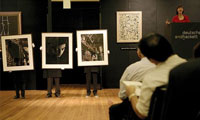 Art royalties plan gets the brush-off
Art royalties plan gets the brush-off Going, going... works up for auction at Paddington Town Hall last week. Photo: Sahlan Hayes
THE resale royalty scheme for Australian artists has been labelled a "bureaucratic nightmare" for galleries and auction houses that will do nothing to help artists and their families.
"I think everyone's terrified," said gallery owner Jenny Dickerson, the wife of artist Robert Dickerson. "I can't see the point of it all. It's just another art bureaucracy."
The federal scheme gives artists 5 per cent of the sale price each time their work is resold and applies up to 70 years after their death for works sold for more than $1000.
Six weeks before the scheme's launch on June 9, gallery owners and auction houses say they remain in the dark about how it will operate.
"Not a single gallery knows how to keep the books on it," Ms Dickerson said. "No one knows how to cope with it. It's another batts bureaucracy. It's all going to be a mess."
Auctioneer Damian Hackett said Australia's small art market, in which turnover halved between 2007 and 2009, would struggle to absorb the costs of the scheme. He said the government treated collectors with disdain and dealers as people who took rather than added value.
"The resale royalty should be added to the list of hastily implemented, ill-conceived Rudd Government catastrophes," he said.
The new law forces sellers, buyers, auction houses, commercial galleries and dealers to inform the Copyright Agency Ltd about all commercial resales.
CAL's spokeswoman Zoe Rodriguez said the collecting agency was in constant contact with stakeholders about implementing the scheme. "We're fairly confident we'll be ready for 9 June start date," she said.
But art dealer Denis Savill said: "We have not received one bit of official paper. We know nothing about how it will be implemented."
Even supporters of the resale royalty are critical of its implementation. Gallery owner Michael Reid said the scheme would be a costly administrative burden for commercial galleries and dealers.
"Why should I be expected to undertake this time and paper burden for nothing? The absence of any details as to how the scheme will work screams volumes as to arts policy incompetency," Mr Reid said.
Federal Arts Minister Peter Garrett told Parliament the resale royalty was "particularly important for indigenous artists who have sadly continued to be exploited by some unscrupulous dealers".
But the focus on indigenous artists was overblown, said John Oster, executive officer of Desart, which represents all Central Australian art centres. "As far as poverty is concerned, no scheme like this will solve all the problems in the world," he said.
"There is a limited benefit here and we must recognise that this along with a whole lot of other measures are needed. The resale royalty is not going to solve indigenous poverty."
The scheme is likely to benefit descendants of artists such as Brett Whiteley and Fred Williams who already do well in the primary market. A similar scheme operates in several European countries including France, where the vast majority of resale royalties flow to the estates of a handful of artists.
"If we are intent on socially engineering a fairer go for all through a levy system, then the outcome should benefit living artists in need of financial support now," Mr Reid said.
"Resale royalties should go into a general fund to support the practice of living artists rather than maintaining the lifestyle to which a few artists' heirs have become accustomed."
 Art royalties plan gets the brush-off
Art royalties plan gets the brush-off